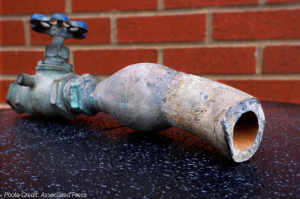
Lead pipe replacement in action: New case examples highlight innovative approaches to financing, outreach, and more
Sam Lovell, Project Manager.
[pullquote]
See new case examples of state and local agencies, community groups, and other stakeholders tackling lead service line replacement challenges.
[/pullquote]Across the country, over 9 million homes still get their water through a lead pipe, called a lead service line (LSL). Fully replacing LSLs poses a myriad of challenges – cost chief amongst them – but replacement is critical to protecting the public from the harms posed by lead exposure. It is also a necessary step to upgrading the country’s aging water infrastructure.
To assist water systems, elected officials, health professionals, and other key stakeholders with navigating these challenges to accelerating LSL replacement, the Lead Service Line Replacement Collaborative developed an online toolkit several years ago. EDF is a founding member of the Collaborative, which now has 27 members representing public health, water utility, environmental, labor, consumer, housing, and state and local governmental organizations. The toolkit includes everything from technical replacement information to recent LSL replacement news to equity considerations.
Now, the Collaborative is featuring case examples and interviews with states, water utilities, and advocates advancing LSL replacement with innovative strategies.
The case examples include:
- Unlocking Funding to Support Private-Side LSL Replacement: Wisconsin Department of Natural Resources’ Rebecca Scott outlines steps the state has taken to provide funding to communities and unexpected challenges they encountered along the way: “In general, small communities need more tailored assistance…I’ve learned that flexibility is key.”
- Roles for Community Groups in LSL Replacement Efforts: “We had a dedicated Department of Public Works and a community used to advocating for itself. With the funding, we had everything we needed. I see our role as creating momentum. We helped the city see this was doable.” Clean Water Fund’s Maureo Fernández y Mora describes how CWF served as both an ally to the water utility in Chelsea, Massachusetts and a bridge to the community to accelerate LSL replacement.
- Working with Critical Customers to Replace LSLs: Child care facilities and schools are “critical customers” for water utilities to coordinate LSL replacement. Denver Water’s Alexis Woodrow offers insights from the utility’s experience working with public schools, charter schools, and other facilities: “The process of replacing an LSL ultimately requires working closely with the person in charge of the property, whether that’s the homeowner, the on-site manager or facilities manager or an off-site organizational coordinator.”
- How State Agencies Can Support LSL Replacement: “Give praise where it is due. Washington made a point to acknowledge and draw media attention to communities that were proactive in addressing lead in their water systems.” Washington Department of Health’s Scott Torpie describes lessons learned from inventorying LSLs following a state directive, funding projects, and more.
The Collaborative will continue updating the Case Examples page to highlight additional stories. Let them know if you have an example!













One Comment
I would like updates on the replacement of LSL
in New Jersey. The water exceeded the allowable amount of lead awhile ago. They were going to replace pipelines, etc, but that’s the last we heard of it. We need to have follow-up on current readings and what’s being done about it in the public domain.